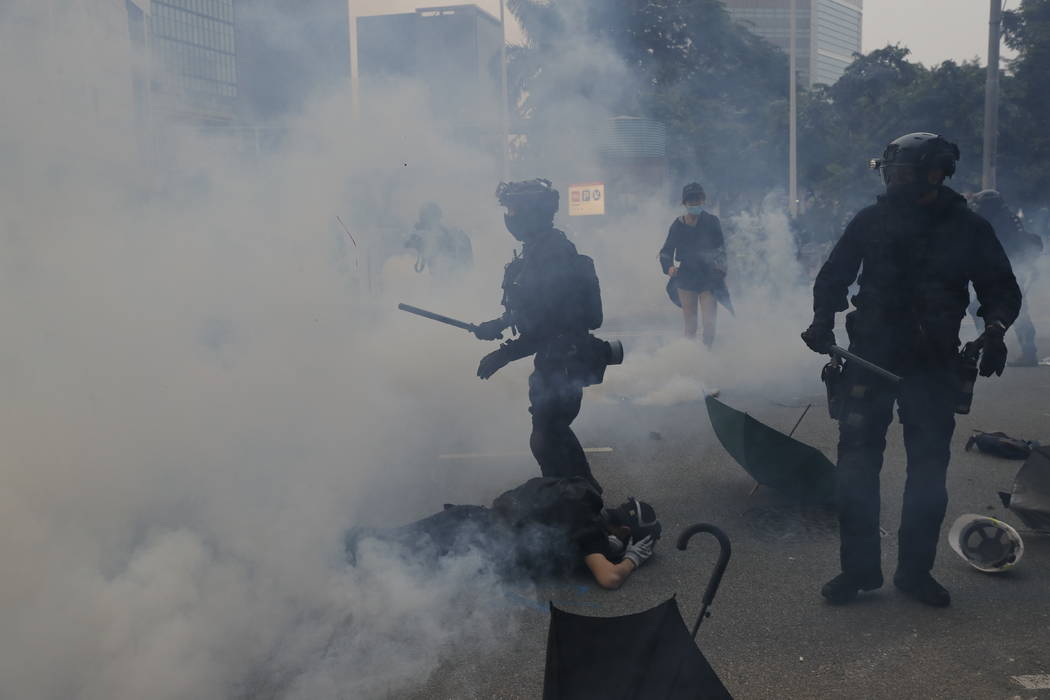More violence grips Hong Kong ahead of China’s National Day
HONG KONG — Protesters and police clashed in Hong Kong for a second straight day on Sunday, throwing the semiautonomous Chinese territory’s business and shopping belt into chaos and sparking fears of more ugly scenes leading up to China’s National Day holiday this week.
Riot police repeatedly fired blue liquid — used to identify protesters — from a water cannon truck and multiple volleys of tear gas after demonstrators hurled Molotov cocktails at officers and targeted the city’s government office complex.
It was a repeat of Saturday’s clashes and part of a familiar cycle since pro-democracy protests began in early June. The protests were sparked by a now-shelved extradition bill and have since snowballed into an anti-China movement.
“We know that in the face of the world’s largest totalitarian regime — to quote Captain America, ‘Whatever it takes,’” Justin Leung, a 21-year-old demonstrator who covered his mouth with a black scarf, said of the violent methods deployed by hard-line protesters. “The consensus right now is that everyone’s methods are valid and we all do our part.”
Protesters are planning to march again Tuesday despite a police ban, raising fears of more violent confrontations that would embarrass Chinese President Xi Jinping as his ruling Communist Party marks 70 years since taking power. Posters are calling for Oct. 1 to be marked as “A Day of Grief.”
“So many youngsters feel that they’re going to have no future because of the power of China,” Andy Yeung, 40, said as he pushed his toddler in a stroller. “It’s hopeless for Hong Kong. If we don’t stand up, there will be no hope.”
Hong Kong’s government has already scaled down the city’s National Day celebrations, canceling an annual fireworks display and moving a reception indoors.
Despite security concerns, the government said Sunday that Chief Executive Carrie Lam, Hong Kong’s leader, will lead a delegation of over 240 people to Beijing on Monday to participate in National Day festivities.
Sunday’s turmoil started in the early afternoon when police fired tear gas to disperse a large crowd that had amassed in the popular Causeway Bay shopping district. But thousands of people regrouped and defiantly marched along a main thoroughfare toward government offices, crippling traffic.
Protesters, many clad in black with umbrellas and carrying pro-democracy posters and foreign flags, sang songs and chanted “Stand with Hong Kong, fight for freedom.” Some defaced, tore down and burned National Day congratulatory signs, setting off a huge blaze on the street. Others smashed windows and lobbed gasoline bombs into subway exits that had been shuttered.
Police then fired a water cannon and tear gas as the crowd approached the government office complex. Most fled but hundreds returned, hurling objects into the complex.
Members of an elite police squad, commonly known as raptors, then charged out suddenly from behind barricades, taking many protesters by surprise. Several who failed to flee in time were subdued and detained in a scene of chaos.
The raptors, backed by scores of riot police, pursued protesters down roads to nearby areas. Officers continued to fire a water cannon and more tear gas, and the cat-and-mouse clashes lasted late into the night. Streets were left littered with graffiti on walls and debris.
The demonstration was part of global “anti-totalitarianism” rallies to denounce “Chinese tyranny.” Thousands rallied in Taipei, Taiwan’s capital, while more than 1,000 took part in a rally in Sydney.
The protracted unrest, approaching four months long, has battered Hong Kong’s economy, with businesses and tourism plunging.
Chief Executive Lam held her first community dialogue with the public on Thursday in a bid to defuse tensions but failed to persuade protesters, who vowed to press on until their demands are met, including direct elections for the city’s leaders and police accountability.
Earlier Sunday, hundreds of pro-Beijing Hong Kong residents sang the Chinese national anthem and waved red flags at the Victoria Peak hilltop and a waterfront cultural center in a show of support for Chinese rule.
“We want to take this time for the people to express our love for our country, China. We want to show the international community that there is another voice to Hong Kong” apart from the protests, said organizer Innes Tang.
Mobs of Beijing supporters have appeared in malls and on the streets in recent weeks to counter pro-democracy protesters, leading to brawls between the rival camps.
Many people view the extradition bill, which would have sent criminal suspects to mainland China for trial, as a glaring example of the erosion of Hong Kong’s autonomy when the former British colony returned to Chinese rule in 1997.
China has denied chipping away at Hong Kong’s freedoms and accused the U.S. and other foreign powers of fomenting the unrest to weaken its dominance.
Associated Press journalists Ken Moritsugu in Beijing and Katie Lam and John Leicester in Hong Kong contributed to this report.




















